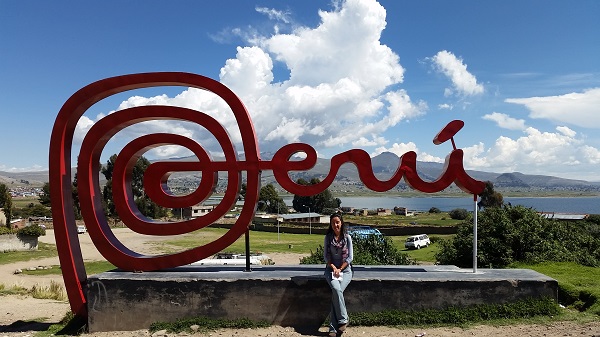 A Puno abbiamo trovato un ostello carinissimo, tranquillo e pulito gestito da una famiglia super gentile che ci ha dato un po' di dritte sui tour possibili da fare, come alle isole galleggianti sul lago Titicaca.
La cittadina di Puno non e' nulla di che ma ci sono tanti posti per la ristorazione che offrono menu di comida casera (cibo fatto in casa) a due soldi, che a noi piacciono tanto tanto. Poi c'è anche la Plaza de las armas (la nostra Piazza Roma) con un corso molto carino e curato che arriva ad un'altra piazza sempre pedonale. Finita Puno.
Le isole galleggianti: Los Uros e Tachile
A Puno abbiamo trovato un ostello carinissimo, tranquillo e pulito gestito da una famiglia super gentile che ci ha dato un po' di dritte sui tour possibili da fare, come alle isole galleggianti sul lago Titicaca.
La cittadina di Puno non e' nulla di che ma ci sono tanti posti per la ristorazione che offrono menu di comida casera (cibo fatto in casa) a due soldi, che a noi piacciono tanto tanto. Poi c'è anche la Plaza de las armas (la nostra Piazza Roma) con un corso molto carino e curato che arriva ad un'altra piazza sempre pedonale. Finita Puno.
Le isole galleggianti: Los Uros e Tachile
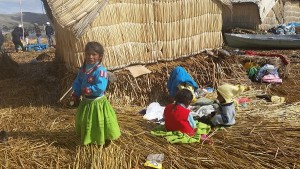 Le isolette artificiali Los Uros sono (ora fintamente) popolate da discendenti Aymara mentre Taquile e' ancora veramente abitata da una comunità Quechua. Quindi a pochi km di distanza ci sono ben tre lingue nazionali, ufficialmente riconosciute che convivono.
Partiamo dal Lago che si può chiamare sia Titicaca che Titikaka, dipende dall'idioma che si segue, il castigliano o il quechua (Paolo questa e' per te!). Il lago si trova a 3900 metri di altitudine, e' il più alto al mondo ed ha profondità' fino a 300 metri, 8560 km2 di superficie (160 per 60 km); ha nobili origini glaciali e l'acqua limpida e' potabile – tranne vicino Puno che sono zozzoni e inquinano.
Le isolette artificiali Los Uros sono (ora fintamente) popolate da discendenti Aymara mentre Taquile e' ancora veramente abitata da una comunità Quechua. Quindi a pochi km di distanza ci sono ben tre lingue nazionali, ufficialmente riconosciute che convivono.
Partiamo dal Lago che si può chiamare sia Titicaca che Titikaka, dipende dall'idioma che si segue, il castigliano o il quechua (Paolo questa e' per te!). Il lago si trova a 3900 metri di altitudine, e' il più alto al mondo ed ha profondità' fino a 300 metri, 8560 km2 di superficie (160 per 60 km); ha nobili origini glaciali e l'acqua limpida e' potabile – tranne vicino Puno che sono zozzoni e inquinano.
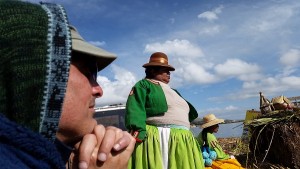 In quechua significa 'roccia puma' poiché se ne sta tranquillo nel mezzo delle Ande che lo circondano. Sulle rive del lago crescono degli arbusti multiuso, chiamati 'totora'. Questi vengono utilizzati per alzare il livello delle isole Uros e per rivestire le case che ci sono sopra, ma anche come una sana merenda. Infatti la parte bianca vicino alla radice e' commestibile, anzi sembrerebbe che faccia bene ai denti.
Le isole Uros sono state artificialmente costruite dagli Aymara per salvarsi dalla invasione dei conquistadores. Oggi sono un'attrazione turistica al 100%, con i finti indigeni che quotidianamente mostrano i loro usi e costumi inscenando un siparietto un po patetico, con tanto di canzoncina. Ci ha fatto un po' tristezza, soprattutto l'insistenza nella vendita di tovaglie, cuscini e vari oggetti di fattura artigianale.
Tuttavia,visto che il nostro bicchiere e' sempre mezzo pieno (con un bel vinello bianco):
In quechua significa 'roccia puma' poiché se ne sta tranquillo nel mezzo delle Ande che lo circondano. Sulle rive del lago crescono degli arbusti multiuso, chiamati 'totora'. Questi vengono utilizzati per alzare il livello delle isole Uros e per rivestire le case che ci sono sopra, ma anche come una sana merenda. Infatti la parte bianca vicino alla radice e' commestibile, anzi sembrerebbe che faccia bene ai denti.
Le isole Uros sono state artificialmente costruite dagli Aymara per salvarsi dalla invasione dei conquistadores. Oggi sono un'attrazione turistica al 100%, con i finti indigeni che quotidianamente mostrano i loro usi e costumi inscenando un siparietto un po patetico, con tanto di canzoncina. Ci ha fatto un po' tristezza, soprattutto l'insistenza nella vendita di tovaglie, cuscini e vari oggetti di fattura artigianale.
Tuttavia,visto che il nostro bicchiere e' sempre mezzo pieno (con un bel vinello bianco):
- ci e' piaciuta l'idea dei locali di mettere un timbro sul passaporto con l'indicazione delle isole del Titicaca;
- abbiamo contribuito all'economia locale acquistando, e pagando tre volte tanto, una piccola pittura;
- nel nostro gruppo, abbiamo incontrato una coppia di francesi che vivono a Lima da anni, dopo aver vissuto in altri paesi dell'America del Sud, come la Colombia; Bruno e Maria Jose, due persone molto simpatiche e interessanti.
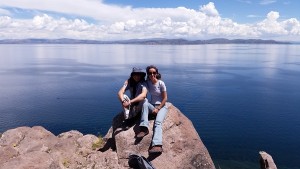 L'isola di Taquile e' stata tutta un'altra cosa: vera, verace e veritiera. Prima di tutto quest'isola e' stata dichiarata Patrimonio culturale intangibile dell'umanità dall'UNESCO. Poi ci sono circa 2000 persone vere che vivono qui.
La comunità che popola l'isola riceve giornalmente circa 200 turisti, che hanno il permesso di fare un giro scortati dalla guida, pranzare in uno dei ristoranti dell'isola e tornare da dove sono venuti. Tutto sotto l'occhio vigile del capo dell'isola, che ci ha persino contati al nostro sbarco (tanto per non sbagliarsi).
L'isola e' un un mondo a parte, lontano dalla modernità a cui siamo abituati: uomini e donne vestono con gli abiti tradizionali che indicano status sociale e credenze religiose, tutto testimoniato dai cappelli degli uomini o dalle borse per le foglie di coca che portano sempre in vita, o dalle gonne delle donne.
L'isola di Taquile e' stata tutta un'altra cosa: vera, verace e veritiera. Prima di tutto quest'isola e' stata dichiarata Patrimonio culturale intangibile dell'umanità dall'UNESCO. Poi ci sono circa 2000 persone vere che vivono qui.
La comunità che popola l'isola riceve giornalmente circa 200 turisti, che hanno il permesso di fare un giro scortati dalla guida, pranzare in uno dei ristoranti dell'isola e tornare da dove sono venuti. Tutto sotto l'occhio vigile del capo dell'isola, che ci ha persino contati al nostro sbarco (tanto per non sbagliarsi).
L'isola e' un un mondo a parte, lontano dalla modernità a cui siamo abituati: uomini e donne vestono con gli abiti tradizionali che indicano status sociale e credenze religiose, tutto testimoniato dai cappelli degli uomini o dalle borse per le foglie di coca che portano sempre in vita, o dalle gonne delle donne.
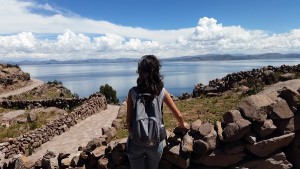 La passeggiata e' durata un'ora e mezza iniziando con una salita da brivido che ci ha tolto il fiato a tutti. Con tranquillità Rene', la guida, ci ha fatto notare che gli uomini dell'isola portano tutto a spalla in quando non ci sono animali da carico, quindi niente cavalli o muli.
Eravamo già tutti paonazzi e sudati per la salita, ora con gli occhi di fuori dallo stupore. Pensiero comune: devono essere molto atletici o doparsi di coca come matti (abbiamo le prove che e' la seconda ipotesi la piu' vera).
La passeggiata e' durata un'ora e mezza iniziando con una salita da brivido che ci ha tolto il fiato a tutti. Con tranquillità Rene', la guida, ci ha fatto notare che gli uomini dell'isola portano tutto a spalla in quando non ci sono animali da carico, quindi niente cavalli o muli.
Eravamo già tutti paonazzi e sudati per la salita, ora con gli occhi di fuori dallo stupore. Pensiero comune: devono essere molto atletici o doparsi di coca come matti (abbiamo le prove che e' la seconda ipotesi la piu' vera).
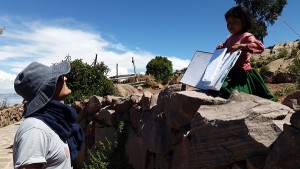 L'isola e' molto bella, con terrazzamenti a coltivazione di quinoa, patate e mais. Ovviamente i peruviani rivendicano l'origine della patata contrastando i boliviani sul tema, la guida sempre molto placida e diplomatica ha parlato delle origini dall'Altipiano, che racchiude entrambi i paesi, e anche un pezzettino del Cile.
Taquile e' stata un'esperienza culturale ricca ed interessante, che ci ha permesso di immergerci nella vita e nei costumi della comunità e di godere di un paesaggio rilassante e unico.
L'isola e' molto bella, con terrazzamenti a coltivazione di quinoa, patate e mais. Ovviamente i peruviani rivendicano l'origine della patata contrastando i boliviani sul tema, la guida sempre molto placida e diplomatica ha parlato delle origini dall'Altipiano, che racchiude entrambi i paesi, e anche un pezzettino del Cile.
Taquile e' stata un'esperienza culturale ricca ed interessante, che ci ha permesso di immergerci nella vita e nei costumi della comunità e di godere di un paesaggio rilassante e unico.
Peru – Puno and the floating Islands
 From Copacabana (Bolivia), we took a bus to Puno, a small town on Titicaca Lake but on the Peruvian side.
The ride on the bus (really loaded of gringos) was the most troubled one we have done so far. With 'gringos' I mean - in a totally racist and partial approach, all pale or cooked-red skin tourists, wearing white sock under the sandal. All of them equipped with thousand cameras, GPS devices and technological tools while visiting wild places where often there is not even running water... I include in this category also young English speakers – speaking only one language, who believe they have understood everything about life and complain about the inconvenience of no having hot water or the prohibition to throw toilet paper in the toilet but to dispose it in the bucket next to it.
I say loud and clear: "But who let you free? Quedarse a la casa!"
From Copacabana (Bolivia), we took a bus to Puno, a small town on Titicaca Lake but on the Peruvian side.
The ride on the bus (really loaded of gringos) was the most troubled one we have done so far. With 'gringos' I mean - in a totally racist and partial approach, all pale or cooked-red skin tourists, wearing white sock under the sandal. All of them equipped with thousand cameras, GPS devices and technological tools while visiting wild places where often there is not even running water... I include in this category also young English speakers – speaking only one language, who believe they have understood everything about life and complain about the inconvenience of no having hot water or the prohibition to throw toilet paper in the toilet but to dispose it in the bucket next to it.
I say loud and clear: "But who let you free? Quedarse a la casa!"
 In Puno we found a cute hostel: quiet and clean, run by a super nice family that gave us a little hint on possible tour to do, as for example the floating islands on Lake Titicaca.
The city of Puno is nothing special, but there are many restaurants that offer menu with 'comida casera' (homemade food) for few coins, which we love so much. Then there is also the Plaza de Armas (the Italian Piazza Roma) with a very cute and nice street to get to another square - still pedestrian. This is Puno.
The floating islands: Los Uros and Tachile
The artificial islands Los Uros are (now falsely) populated by descendants Aymara, while Taquile is still truly inhabited by a Quechua community. So at few miles away there are three national, officially recognised and living languages.
In Puno we found a cute hostel: quiet and clean, run by a super nice family that gave us a little hint on possible tour to do, as for example the floating islands on Lake Titicaca.
The city of Puno is nothing special, but there are many restaurants that offer menu with 'comida casera' (homemade food) for few coins, which we love so much. Then there is also the Plaza de Armas (the Italian Piazza Roma) with a very cute and nice street to get to another square - still pedestrian. This is Puno.
The floating islands: Los Uros and Tachile
The artificial islands Los Uros are (now falsely) populated by descendants Aymara, while Taquile is still truly inhabited by a Quechua community. So at few miles away there are three national, officially recognised and living languages.
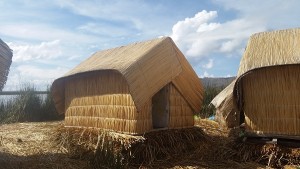 We start from the Titicaca Lake: you can call it also Titikaka; it depends by the idiom you follow, the Spanish or Quechua (Paolo, this is for you!). The lake is located at 3900 meters above sea level; it is the highest in the world and it has up to 300 meters deepth, 8560 km2 (160 to 60 km). It has noble glacial origins and its clear water is drinkable - except near Puno, which is polluted and dirty.
We start from the Titicaca Lake: you can call it also Titikaka; it depends by the idiom you follow, the Spanish or Quechua (Paolo, this is for you!). The lake is located at 3900 meters above sea level; it is the highest in the world and it has up to 300 meters deepth, 8560 km2 (160 to 60 km). It has noble glacial origins and its clear water is drinkable - except near Puno, which is polluted and dirty.
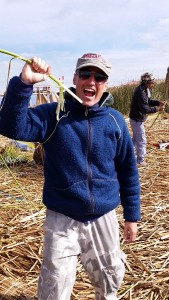 In Quechua Titikaka means the puma rock' because it is quiet, in the middle of the Andes that surround it. On the banks of the lake it grow a multi-purpose reed, called 'totora'. This is used to raise the level of Uros islands and to coat the homes that are above, but also as a healthy snack. In fact the white part near the root is edible and it'd seem that is good for teeth.
The Uros islands were artificially built by Aymara to save themselves from the invasion of the conquistadors.
Today they are a tourist attraction at 100%, with the fake natives who daily show their customs and traditions by staging a performance a bit pathetic, including a little song. It was a bit sad, especially the insistence in selling tablecloths, pillows and various objects of craftsmanship.
However, since our glass is always half full (with a nice white wine):
In Quechua Titikaka means the puma rock' because it is quiet, in the middle of the Andes that surround it. On the banks of the lake it grow a multi-purpose reed, called 'totora'. This is used to raise the level of Uros islands and to coat the homes that are above, but also as a healthy snack. In fact the white part near the root is edible and it'd seem that is good for teeth.
The Uros islands were artificially built by Aymara to save themselves from the invasion of the conquistadors.
Today they are a tourist attraction at 100%, with the fake natives who daily show their customs and traditions by staging a performance a bit pathetic, including a little song. It was a bit sad, especially the insistence in selling tablecloths, pillows and various objects of craftsmanship.
However, since our glass is always half full (with a nice white wine):
- we liked the idea of the premises to put a stamp on the passport with an indication of the islands of Titicaca;
- we have contributed to the local economy by purchasing, and paying three times more, a small painting;
- in our group, we met a French couple living in Lima for years, after living in other South American countries, such as Colombia; Bruno and Maria Jose, very nice and interesting people.
 The communities, that inhabit the island, receive daily about 200 tourists, who are allowed to take a tour escorted by a guide, have lunch in one of the restaurants on the island and return to where they came from. All under the watchful eye of the head of the island, that he even counted us when we arrived (not to make a mistake).
The communities, that inhabit the island, receive daily about 200 tourists, who are allowed to take a tour escorted by a guide, have lunch in one of the restaurants on the island and return to where they came from. All under the watchful eye of the head of the island, that he even counted us when we arrived (not to make a mistake).
 The island is a world apart, far from modernity to which we are accustomed: men and women dress in traditional clothes that indicate social status and religious beliefs, all witnessed by men's hats or bags for coca leaves that always bring to their waist, or by the skirts of women.
The walk lasted an hour and a half, starting with a thrilling climb that took away our breath. Calmly Rene, the guide, pointed out that the men of the island bring everything to shoulder as there are not animals to load, so no horses or mules.
We were all red-faced and sweaty for the climb, now with eyes outside, totally amazement.
Common thought: they must be very athletic or chew coca like crazy (and we have evidence that 'the latter is the more true').
The island is a world apart, far from modernity to which we are accustomed: men and women dress in traditional clothes that indicate social status and religious beliefs, all witnessed by men's hats or bags for coca leaves that always bring to their waist, or by the skirts of women.
The walk lasted an hour and a half, starting with a thrilling climb that took away our breath. Calmly Rene, the guide, pointed out that the men of the island bring everything to shoulder as there are not animals to load, so no horses or mules.
We were all red-faced and sweaty for the climb, now with eyes outside, totally amazement.
Common thought: they must be very athletic or chew coca like crazy (and we have evidence that 'the latter is the more true').
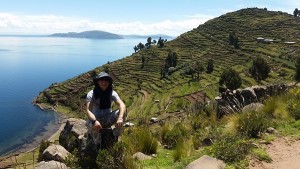 The island is very nice, with terraced cultivation of quinoa, potatoes and corn. Obviously Peruvians claim the origin of the potato, counteracting Bolivians on the topic: the guide always very calm and diplomatic spoke about the origins from the Altiplano, which includes both countries, and also a piece of Chile.
Taquile was a cultural, rich and interesting experience, which allowed us to immerse ourselves in the lives and customs of the community and to enjoy a relaxing and unique landscape.
The island is very nice, with terraced cultivation of quinoa, potatoes and corn. Obviously Peruvians claim the origin of the potato, counteracting Bolivians on the topic: the guide always very calm and diplomatic spoke about the origins from the Altiplano, which includes both countries, and also a piece of Chile.
Taquile was a cultural, rich and interesting experience, which allowed us to immerse ourselves in the lives and customs of the community and to enjoy a relaxing and unique landscape. 